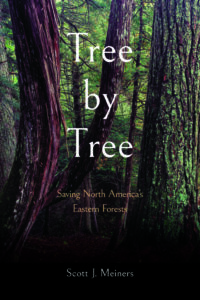 Like far too many people living in a modern society today, I’m rubbish at identifying trees. Even though I live surrounded by them, my knowledge of them fails rapidly after only the most common half-dozen or so to my home territory. That’s not surprising. Trees exist in such remarkably different scales than humans. They live far longer lives, grow far more slowly, achieve much larger physical proportions, and – if recent discoveries about their inter-connectedness with fungi prove correct – communicate in ways we can barely comprehend. However a downside of existing at such scales relative to humans as trees do can also pose a significant threat to them: we humans, Gaia’s “special children” in being the cause of so many unnatural changes on the planet, are unable to readily perceive when trees are in trouble. Should the American Robins or Blue Jays, or any creature most humans can readily identify and see with regularity, rapidly decline in numbers, alarm bells would be rung near and far. However if the American Elms rapidly began to sicken and die, few but the most botanically astute would likely even notice until it was far too late.
Like far too many people living in a modern society today, I’m rubbish at identifying trees. Even though I live surrounded by them, my knowledge of them fails rapidly after only the most common half-dozen or so to my home territory. That’s not surprising. Trees exist in such remarkably different scales than humans. They live far longer lives, grow far more slowly, achieve much larger physical proportions, and – if recent discoveries about their inter-connectedness with fungi prove correct – communicate in ways we can barely comprehend. However a downside of existing at such scales relative to humans as trees do can also pose a significant threat to them: we humans, Gaia’s “special children” in being the cause of so many unnatural changes on the planet, are unable to readily perceive when trees are in trouble. Should the American Robins or Blue Jays, or any creature most humans can readily identify and see with regularity, rapidly decline in numbers, alarm bells would be rung near and far. However if the American Elms rapidly began to sicken and die, few but the most botanically astute would likely even notice until it was far too late.
Prof. Scott Meiners not only would notice, but has already done so, and in his new book Tree by Tree; Saving North America’s Eastern Forests, he presents overviews of five tree species – the American Elm, the American Chestnut, the Eastern Hemlock, the White Ash, and the Sugar Maple – explaining their ecological, economic, and cultural value, and the dangers that faced, are facing, or will likely face them at a truly existential level. Written at a straightforward manner and at a practical level, this is a book well worth the attention of all who value trees, whether economically, aesthetically, or ecologically.
Nota bene: Prof. Meiners recently sat for an interview with the Cornell University Press 1869 podcast team to discuss Tree by Tree. It’s thirty-two minutes and eleven seconds of time very much worth giving ear.
